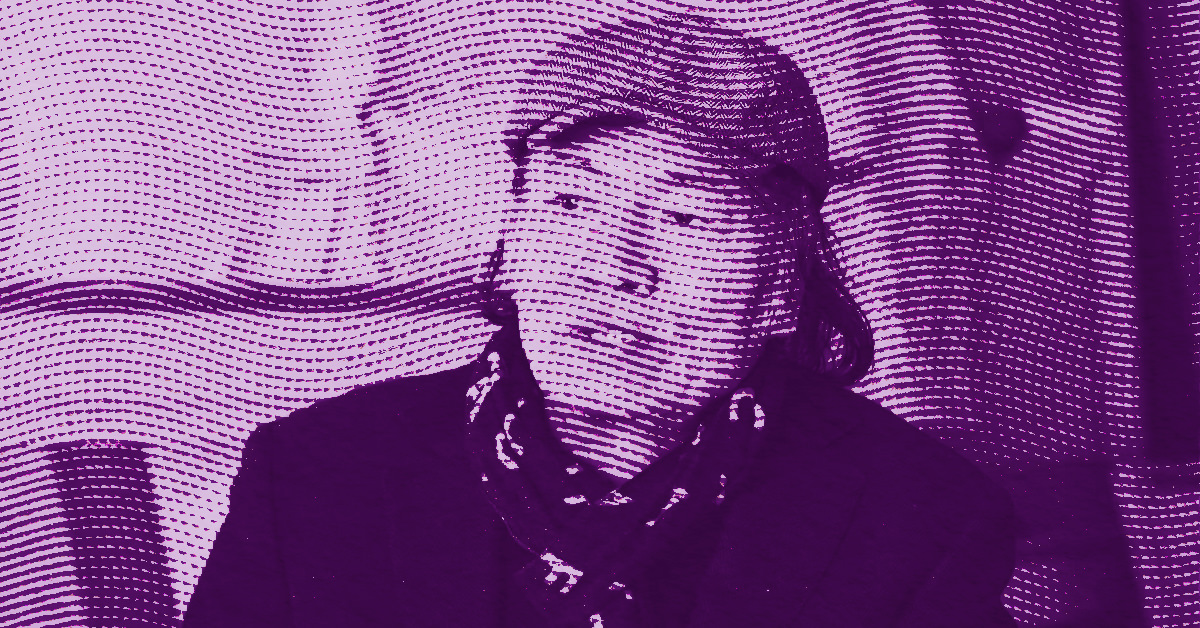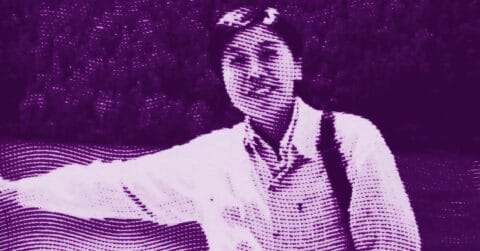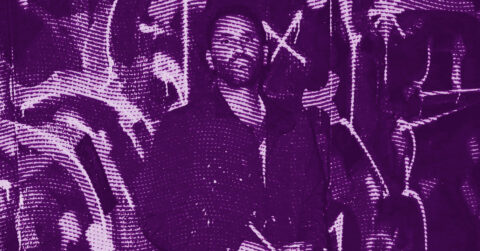Listen to me carefully, you bunch of snobs. For over forty years, Chao Ge has traversed the territories of contemporary Chinese art with the silent determination of a nomad who knows his destination. Born in Inner Mongolia in 1957, this man has managed to build a body of work unlike any other, a painting that refuses the shortcuts of the time while speaking with a troubling acuity about our era. Where so many contemporary artists get lost in the meanders of provocation or fashion, Chao Ge has chosen the path of depth, the one that leads to the enduring sources of art.
The soul of a builder
When one observes Chao Ge’s canvases, one thing is clear: we are facing an architect of the modern soul. His characters, frozen in eternal contemplation, inhabit mental spaces constructed with the rigor of a cathedral builder. This architectural dimension of his work finds its roots in a millenary tradition that goes back to the master builders of Romanesque and Gothic art. Like them, Chao Ge understands that true art does not merely decorate: it structures, orders, elevates.
In his portraits from the 1990s, particularly in “L’Homme sensible” (1990), the artist proceeds by structural purification. Every line of the face, every cast shadow participates in an architectural whole where nothing is left to chance. This constructive approach recalls the spirit of medieval master builders who, according to Viollet-le-Duc, “never composed a building without having contemplated all its parts in their relation to the whole” [1]. For Chao Ge, the human face becomes a cathedral, and each emotion is inscribed in the stone of the canvas like a sculpted capital.
The Mongolian artist does not stop at this superficial analogy. He pushes the architectural logic further by developing what he himself calls a “breathing painting,” rejecting the shiny surface of traditional oil painting in favor of a technique close to fresco [2]. This technical research testifies to a desire for permanence rooted in monumental art. His canvases aspire to the duration of the painted walls of Giotto or Piero della Francesca, those masters who knew that true art must survive generations.
The spatial organization in Chao Ge’s work also obeys rigorous architectural principles. His compositions are articulated around lines of force that structure the pictorial space as the vaults of a nave organize sacred space. In his Mongolian landscapes, horizons unfold according to a hidden geometry that evokes the golden proportions of ancient builders. This mastery of space reveals an artist aware that painting, like architecture, must create habitable places for the spirit.
But it is in his understanding of time that Chao Ge most clearly reveals his dimension as an architect. His post-2000 works, notably “Juin” (2004) or “Personnage solennel” (2003), testify to a desire to construct images that escape temporal wear. Like cathedrals that endure through the centuries bearing testimony to the faith of their builders, Chao Ge’s canvases aspire to bear witness to a contemplative humanity that refuses contemporary frenzy. This architectural dimension of his work is not metaphorical: it constitutes the backbone of an aesthetic that places construction at the heart of artistic creation.
The psychoanalysis of the contemporary gaze
Chao Ge’s art also reveals a psychoanalytic dimension that radically distinguishes him from his contemporaries. Through his portraits, the artist develops a genuine archaeology of the modern unconscious, exploring the secret territories of the contemporary psyche with the patience of an analyst. This approach is rooted in Freud’s discoveries about the structure of the psychic apparatus, but it goes beyond them to propose an unprecedented mapping of the contemporary soul.
In “L’Homme sensible”, Chao Ge implements a pictorial technique that directly evokes the mechanisms of analysis. The character’s face seems to emerge from the depths of the canvas like a repressed memory surfacing to consciousness. This gradual emergence of form recalls the analytic process where unconscious contents slowly surface into speech. The artist perfectly masters this particular temporality of the unconscious, where past and present blend in a duration that no longer obeys the laws of chronological time.
The pictorial technique itself becomes a psychoanalytic investigative tool. Chao Ge proceeds by layering colored layers that accumulate like memory strata in the psychic apparatus. Each new brushstroke reveals or conceals elements of the previous layer, creating these effects of temporal depth so characteristic of his mature canvases. This method directly evokes the Freudian notion of deferred action, that process by which past events retroactively gain meaning under the light of the present.
The artist also develops a remarkable intuition of the mechanisms of transference and countertransference that govern the analytic relationship. His characters never look directly at the viewer but include them in a complex play of diverted glances that evokes the dynamics of the cure. The viewer is placed in the position of analyst before these faces that seem to carry the weight of an unspeakable secret [3]. This staging of the gaze transforms the act of looking into an analytic experience where everyone projects their own questions.
The temporal dimension of Chao Ge’s work also reveals a profound understanding of psychoanalytic mechanisms. His canvases seem to suspend time, creating these moments of subjective eternity well known to practitioners of analysis. In this stopping of time, Chao Ge’s characters access that inner speech Lacan called “lalangue”, the language before language that carries the trace of our earliest experiences. His Mongolian landscapes function according to the same logic: they do not represent a precise geographical place but rather a psychic space where the individual can find their lost origins.
This psychoanalytic approach culminates in the works from the 2000-2010 period, where Chao Ge develops a true aesthetic of sublimation. His characters seem to have gone through the ordeal of analysis to reach a new serenity. They still bear the marks of their old wounds, but these scars have become sources of beauty. The artist thus shows us that true art is always born from that mysterious alchemy by which suffering transforms into creation, the symptom into a work of art.
The nomadic eternity
Chao Ge’s work contains a fertile contradiction that makes it so rich: how to reconcile the Mongolian nomadic heritage with the aspiration for the eternal? This tension runs through all of his production and gives it an exceptional philosophical dimension. The artist develops an aesthetic of “nomadic eternity” that rejects sedentary certainties to embrace a moving truth, always becoming.
His Mongolian landscapes from the 1990s-2000s testify to this search for the absolute in movement. “Sun on Kerulen” (1994) or “Eji Nuur Lake” reveal spaces that seem to escape the usual laws of geography. These painted territories do not correspond to any precise cartography: they are rather “places of the soul” where the contemporary individual can rediscover their lost spiritual dimension. This imaginary geography is rooted in the Mongolian nomadic tradition which conceives space not as property, but as a territory of passage.
Chao Ge’s stylistic evolution reveals this same nomadic logic applied to artistic creation. Refusing to settle into a style, the artist has continuously shifted his aesthetic research. From the psychological expressionism of the 1990s to the contemplative serenity of recent works, he traces an artistic path that evokes the ancestral migrations of his people. This creative mobility reflects a profoundly Mongolian conception of identity: to be oneself is to accept becoming other, to reject fixed boundaries and embrace the horizon.
The particular temporality of his paintings also reveals this nomadic aesthetic. For Chao Ge, time does not accumulate linearly as in traditional Western art: it unfolds according to a cyclical logic that evokes the seasonal rhythms of the steppe. His characters seem to inhabit an eternal present that contains both the past and the future. This temporal conception recalls traditional Mongolian philosophy which views history not as progression, but as the eternal return of the same fundamental forces.
This nomadic aesthetic finds its most accomplished expression in the mature works where Chao Ge achieves a remarkable synthesis between tradition and modernity. His portraits, notably “Étoiles” (2006) or “Lumière” (2007), reveal faces that carry both the millennia-old imprint of the steppe and the anxiety of the contemporary man. These syntheses are not mere easy syncretism: they testify to a rare ability to think together different temporalities.
Chao Ge thus teaches us that true eternity does not reside in immobility, but in the capacity to constantly renew oneself while preserving the essential. His canvases carry this nomadic lesson: only that which accepts to move survives, only that which consents to metamorphosis endures. In a contemporary world obsessed with speed and immediacy, Chao Ge proposes a precious alternative: nomadic slowness, that way of moving forward that takes the time to look at the horizon [4].
- Eugène Viollet-le-Duc, Dictionnaire raisonné de l’architecture française du XIe au XVIe siècle, Volume IV, Paris, Bance, 1860
- Yin Shuangxi, “Analysis of Chao Ge’s Art”, Revue des Beaux-Arts, 2010
- Interview with Chao Ge, “Art must express the noblest emotions of humanity”, Art China, January 2024
- Exhibition catalog The Renaissance of the Classics: Chao Ge, Vittoriano Museum, Rome, 2006
















